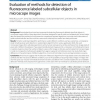BMCBI
2010
13 years 11 months ago
2010
Background: Large-scale genomic studies often identify large gene lists, for example, the genes sharing the same expression patterns. The interpretation of these gene lists is gen...
BMCBI
2010
13 years 11 months ago
2010
Background: The evolution of high throughput technologies that measure gene expression levels has created a data base for inferring GRNs (a process also known as reverse engineeri...
BMCBI
2010
13 years 11 months ago
2010
Background: The construction of interaction networks between proteins is central to understanding the underlying biological processes. However, since many useful relations are exc...
BMCBI
2010
13 years 11 months ago
2010
Background: In the current era of scientific research, efficient communication of information is paramount. As such, the nature of scholarly and scientific communication is changi...
BMCBI
2010
13 years 11 months ago
2010
Background: One of the challenges of bioinformatics remains the recognition of short signal sequences in genomic DNA such as donor or acceptor splice sites, splicing enhancers or ...
BMCBI
2010
2010
Evaluation of methods for detection of fluorescence labeled subcellular objects in microscope images
13 years 11 months ago
Background: Several algorithms have been proposed for detecting fluorescently labeled subcellular objects in microscope images. Many of these algorithms have been designed for spe...
BMCBI
2010
13 years 11 months ago
2010
Background: Sensitivity analysis is an indispensable tool for the analysis of complex systems. In a recent paper, we have introduced a thermodynamically consistent variance-based ...
BMCBI
2010
13 years 11 months ago
2010
Background: The recognition of functional binding sites in genomic DNA remains one of the fundamental challenges of genome research. During the last decades, a plethora of differe...
BMCBI
2010
13 years 11 months ago
2010
Background: DNA microarray technology allows the analysis of genome structure and dynamics at genome-wide scale. Expression microarrays (EMA) contain probes for annotated open rea...
BMCBI
2010
2010
The IronChip evaluation package: a package of perl modules for robust analysis of custom microarrays
13 years 11 months ago
Background: Gene expression studies greatly contribute to our understanding of complex relationships in gene regulatory networks. However, the complexity of array design, producti...






